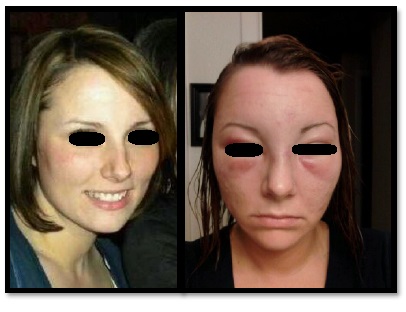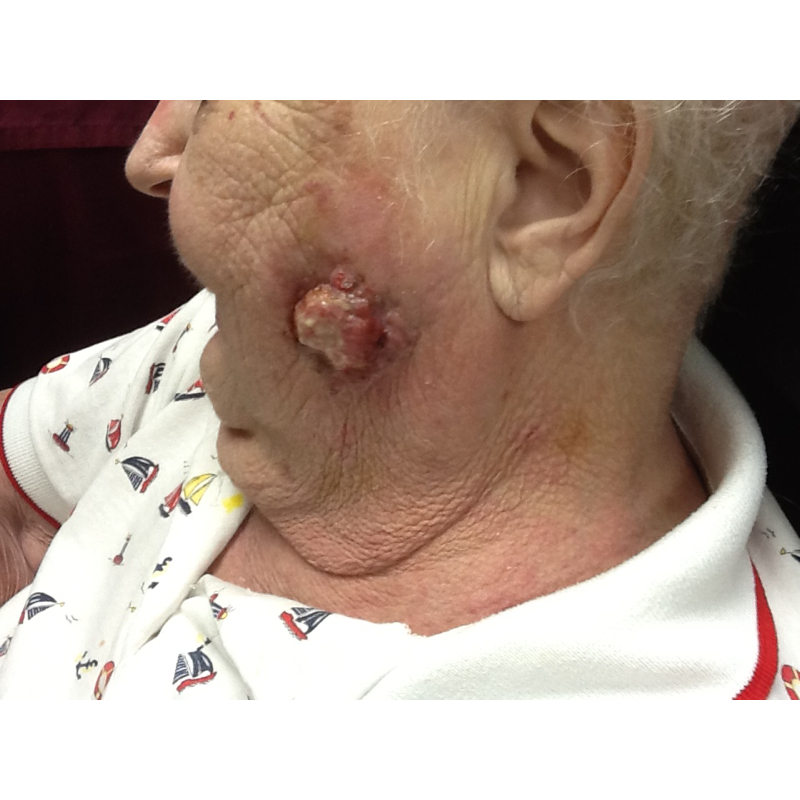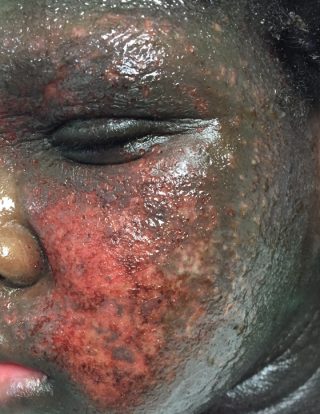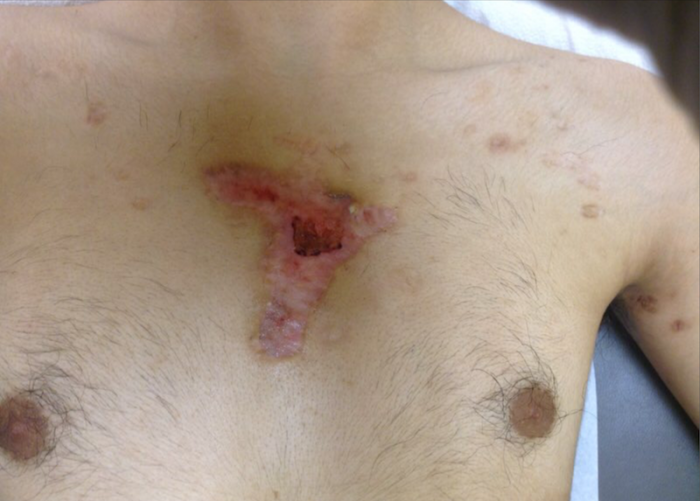CORRECT DIAGNOSIS:
Solid facial edema (Morbihan’s syndrome)
DISCUSSION:
Solid facial edema (Morbihan’s disease) is a rare condition characterized by progressive, symmetric, persistent, non-pitting edema of the central upper face. Typically edema is localized to the glabella, forehead, cheeks, and eyelids. Although its exact etiology is unknown, it is believed to be a rare complication of acne vulgaris, rosacea, or possibly allergic contact dermatitis. Impaired lymphatic drainage and fibrosis secondary to mast cell degranulation in areas where there is chronic inflammation may also play a role. A report of occurrence in a set of identical twins may suggest that genetics could also be a factor.
Clinically there can be a distortion of the midline of the face due to tissue swelling. The edema is characterized as woody or firm and there is typically background erythema. Most commonly, the edema is asymptomatic, although narrowing of the visual field can occur when peri-orbital edema is severe. Histological diagnosis is non-specific, although some biopsies may show an increase in mast cells, and there are no laboratory abnormalities observed.
Differential diagnosis of Morbihan’s includes erysipelas, allergic/irritant contact dermatitis, urticaria, angioedema, dermatomyositis, sarcoidosis, Melkerson-Rosenthol syndrome, systemic lupus erythematosus, nephrotic syndrome, angiosarcoma, lymphoma, or leukemia.
Although the disease may wax and wane, a spontaneous resolution does not typically occur. Treatment with isotretinoin alone or in combination with ketotifen has been reported to be useful in the majority of patients.
TREATMENT:
The recommended treatment for patient was isotretinoin, but the patient was unable to afford it. Several of her larger painful acne cysts were injected with 5 mg/ml Kenalog, which did give the patient some relief. We have inquired about getting patient assistance for isotretinoin therapy.
REFERENCES:
Elston, D. M., et al. (2009). Requisites in dermatology: Dermatopathology. Saunders Elsevier.
Bolognia, J. L., et al. (2008). Dermatology (2nd ed.). Mosby Elsevier.
Wohlrab, J., Lueftl, M., & Marsch, W. C. (2005). Persistent erythema and edema of the midthird and upper aspect of the face (morbus morbihan): Evidence of hidden immunologic contact urticaria and impaired lymphatic drainage. Journal of the American Academy of Dermatology, 52(4), 595-602. https://doi.org/10.1016/j.jaad.2004.08.035
Friedman, S. J., Fox, B. J., & Albert, H. L. (1986). Solid facial edema as a complication of acne vulgaris: Treatment with isotretinoin. Journal of the American Academy of Dermatology, 15(2), 286-289. https://doi.org/10.1016/S0190-9622(86)70080-5
Jungfer, B., Jansen, T., Przybilla, B., & Plewig, G. (1993). Solid persistent facial edema of acne: Successful treatment with isotretinoin and ketotifen. Dermatology, 187(1), 34-37. https://doi.org/10.1159/000246655
Uhara, H., Kawachi, S., & Saida, T. (2000). Solid facial edema in a patient with rosacea. Journal of Dermatology, 27(4), 214-216. https://doi.org/10.1111/j.1346-8138.2000.tb03054.x
Tosti, A., Guerra, L., Bettoli, V., & Bonelli, U. (1987). Solid facial edema as a complication of acne vulgaris in twins. Journal of the American Academy of Dermatology, 17(5), 843-844. https://doi.org/10.1016/S0190-9622(87)70069-8




